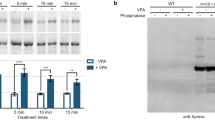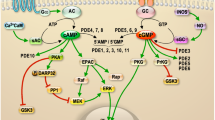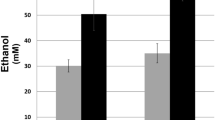Abstract
Myo-inositol exerts behavioral effects in animal models of psychiatric disorders and is effective in clinical trials in psychiatric patients. Interestingly, epi-inositol exerts behavioral effects similar to myo-inositol, even though epi-inositol is not a substrate for synthesis of phosphatidylinositol. We postulated that the behavioral effects of epi-inositol may be due to its effects on gene expression. Yeast INO1expression was measured in northern blots. INM1 was determined by β-galactosidase activity in a strain containing the fusion gene INM1-lacZintegrated into the genome. Epi-inositol affects regulation of expression of the INO1 gene (encoding inositol-1-P synthase), even though it cannot support growth of an inositol auxotroph (suggesting that, as in mammalian cells, it is not incorporated into phosphatidylinositol). Like myo-inositol, although to a lesser extent, epi-inositol causes a significant reduction in INO1 expression, and reverses the lithium- or valproate-induced increase in INO1 expression. However, it does not affect regulation of INM1 (encoding inositol monophosphatase), the expression of which is up-regulated by myo-inositol. The observed regulatory effects of epi-inositol on expression of the most highly regulated gene in the inositol biosynthetic pathway may help to explain how this inositol isomer can exert behavioral effects without being incorporated into phosphatidylinositol.
This is a preview of subscription content, access via your institution
Access options
Subscribe to this journal
Receive 12 print issues and online access
$259.00 per year
only $21.58 per issue
Buy this article
- Purchase on Springer Link
- Instant access to full article PDF
Prices may be subject to local taxes which are calculated during checkout






Similar content being viewed by others
References
De Camilli P, Emr SD, McPherson PS, Novick P . Phosphoinositides as regulators in membrane traffic Science 1996 271: 1533–1539
Parthasarathy R, Eisenberg F . The inositol phospholipids: a sterochemical view of biological activity Biochem J 1986 235: 313–322
Berridge M . Phosphoinositides and signal transduction Rev Clin Basic Pharm 1985 5 Suppl: 5–13
Rouser G, Kritchevsky G, Yamanoto A, Baxter CF . Lipids in the nervous system of different species as a function of age: brain, spinal cord, peripheral nerve purified whole cell preparations, and subcellular particulates: regulatory mechanisms and membrane structure Adv Lipid Res 1972 10: 261–360
Wood AJ, Goodwin GM . A review of the biochemical and neuropharmacological actions of lithium Psychol Med 1987 17: 579–600
Hallcher LM, Sherman WR . The effects of lithium ion and other agents on the activity of myo-inositol-1-phosphatase from bovine brain J Biol Chem 1980 255: 10896–10901
Belmaker RH, Kofman O . Lithium research: state of the art [editorial] Biol Psychiatry 1990 15: 1279–1281
Manji HK, Lenox RH . Lithium: a molecular transducer of mood-stabilization in the treatment of bipolar disorder Neuropsychopharmacology 1998 3: 161–166
Benjamins JA, Agranoff BW . Distribution and properties of CDP-diglyceride:inositol transferase from brain J Neurochem 1969 4: 513–527
Becchetti A, Whitaker M . Lithium blocks cell cycle transition in the first cell cycles of sea urchin embryos, an effect rescued by myo-inositol Development 1997 124: 1099–1107
Busa WB, Gimlich RL . Lithium-induced teratogenesis in frog embryos prevented by a polyphosphoinositide cycle intermediate or a diacylglycerol analog Dev Biol 1989 132: 315–324
Mason R, Biello SM . A neurophysiological study of a lithium-sensitive phosphoinositide system in the hamster suprachiasmic (SCN) biological clock in vitro Neurosci Lett 1992 144: 135–138
Richards MH, Belmaker RH . Epi-inositol is biochemically active in reversing lithium effect on CMP-PA J Neural Transm 1996 103: 1281–1285
Williams MB, Jope RS . Modulation by inositol of cholinergic- and serotonergic-induced seizures in lithium-treated rats Brain Res 1995 685: 169–178
Einat H, Elkabaz-Shwortz Z, Cohen H, Kofman O . Chronic epi-inositol has an anxiolytic-like effect in the plus-maze model in rats Int J Neuropsychopharm 1998 1: 31–34
Patishi Y, Belmaker RH, Bersudsky Y, Kofman O . A comparison of the ability of myo-inositol and epi-inositol to attenuate lithium-pilocarpine seizures in rats Biol Psychiat 1996 39: 829–832
Godfrey PP . Potentiation by lithium of CMP-phosphatidate formation in carbachol-stimulated rat cerebral-cortical slices and its reversal by myo-inositol Biochem J 1989 258: 621–624
Levine J, Barak Y, Gonsalves M, Elizur A, Schor H, Kofman O, Belmaker RH . Double blind study of inositol versus placebo in depression Am J Psychiatry 1995 152: 792–794
Benjamin J, Levine J, Fux M, Aviv A, Levy D, Belmaker RH . Double blind controlled trial of inositol treatment of panic disorder Am J Psychiatry 1995 152: 1084–1086
Cohen H, Kotler M, Kaplan Z, Matar MA, Kofman O, Belmaker RH . Inositol has centrally-mediated behavioral effects with adaptation after chronic administration J Neural Transm 1997 104: 299–305
Einat H, Karbovski H, Korik J, Tsalah D, Belmaker RH . Inositol reduces depressive-like behaviors in two different animal models of depression Psychopharmacology 1999 144: 158–162
Einat H, Shaldubina A, Belmaker RH . Epi-inositol: a potential antidepressant Drug Devel Res 2000 50: 309–315
Carman GM, Henry SA . Phospholipid biosynthesis in the yeast Saccharomyces cerevisiae and interrelationship with other metabolic processes Prog Lipid Res 1999 38: 361–399
Greenberg ML, Lopes JM . Genetic regulation of phospholipid biosynthesis in yeast Microbiol Rev 1996 60: 1–20
Murray M, Greenberg ML . Expression of yeast INM1 encoding inositol monophosphatase is regulated by inositol, carbon source, and growth stage and is decreased by lithium and valproate Mol Microbiol 2000 36: 651–661
UniGen Cluster Analysis www.ncbi.nlm.nih.gov/UniGene/clust.cgi
Bennett MK, Scheller RH . The molecular machinery for secretion is conserved from yeast to neurons Proc Natl Acad Sci 1993 90: 2559–2563
Vaden D, Ding D, Peterson B, Greenberg ML . Lithium and valproic acid decrease inositol mass and increase expression of the INO1 and INO2 genes for inositol biosynthesis in Saccharomyces cerevisiae J Biol Chem 2001 276: 15466–15471
Murray M, Greenberg ML . Regulation of inositol monophosphatase in Saccharomyces cerevisiae Mol Microbiol 1997 3: 541–546
Ashburner BP, Lopes JM . Regulation of yeast phospholipid biosynthetic gene expression in response to inositol involves two superimposed mechanisms Proc Natl Acad Sci USA 1995 92: 9722–9726
Hirsch JP, Henry SA . Expression of the Saccharomyces cerevisiae inositol-1-phosphate synthase (INO1) gene is regulated by factors that affect phospholipid synthesis Mol Cell Biol 1986 6: 3320–3328
Bradford MM . A rapid and sensitive method for the quantitation of microgram quantities of protein utilizing the principle of protein-dye binding Anal Biochem 1976 72: 248–254
Henry SA, Donahue TF, Culbertson MR . Selection of spontaneous mutants by inositol starvation in yeast Mol Gen Genet 1975 143: 5–11
Lopez F, Leube M, Gil-Mascarell R, Navarro-Aviñó JP, Serrano R . The yeast inositol monophosphatase is a lithium- and sodium-sensitive enzyme encoded by a non-essential gene pair Mol Microbiol 1999 4: 1255–1264
Patton-Vogt JL, Griac P, Sreenivas A, Bruno V, Dowd S, Swede MJ et al. Role of the yeast phosphatidylinositol/phosphatidylcholine transfer protein (Sec14p) in phosphatidylcholine turnover and INO1 regulation J Biol Chem 1997 272: 20873–20883
Acknowledgements
We thank Yuly Bersudsky for editorial and statistical consultation. This work was supported by grant MH56220 (to MLG) from the National Institutes of Health.
Author information
Authors and Affiliations
Corresponding author
Rights and permissions
About this article
Cite this article
Shaldubina, A., Ju, S., Vaden, D. et al. Epi-inositol regulates expression of the yeast INO1 gene encoding inositol-1-P synthase. Mol Psychiatry 7, 174–180 (2002). https://doi.org/10.1038/sj.mp.4000965
Received:
Revised:
Accepted:
Published:
Issue Date:
DOI: https://doi.org/10.1038/sj.mp.4000965
Keywords
This article is cited by
-
Experimental and in silico characterization of a biologically active inosose
Structural Chemistry (2013)
-
Cellular Plasticity Cascades in the Pathophysiology and Treatment of Bipolar Disorder
Neuropsychopharmacology (2008)



